1.概述
本篇文章主要介绍如何使用e2studio对瑞萨进行spi配置,同时移植stm32上的W25Q128到瑞萨上,同时通过对该FLASH进行读写操作,验证是否正确。
2.硬件准备
首先需要准备一个开发板,这里我准备的是芯片型号 R7FA2L1AB2DFL 的开发板。
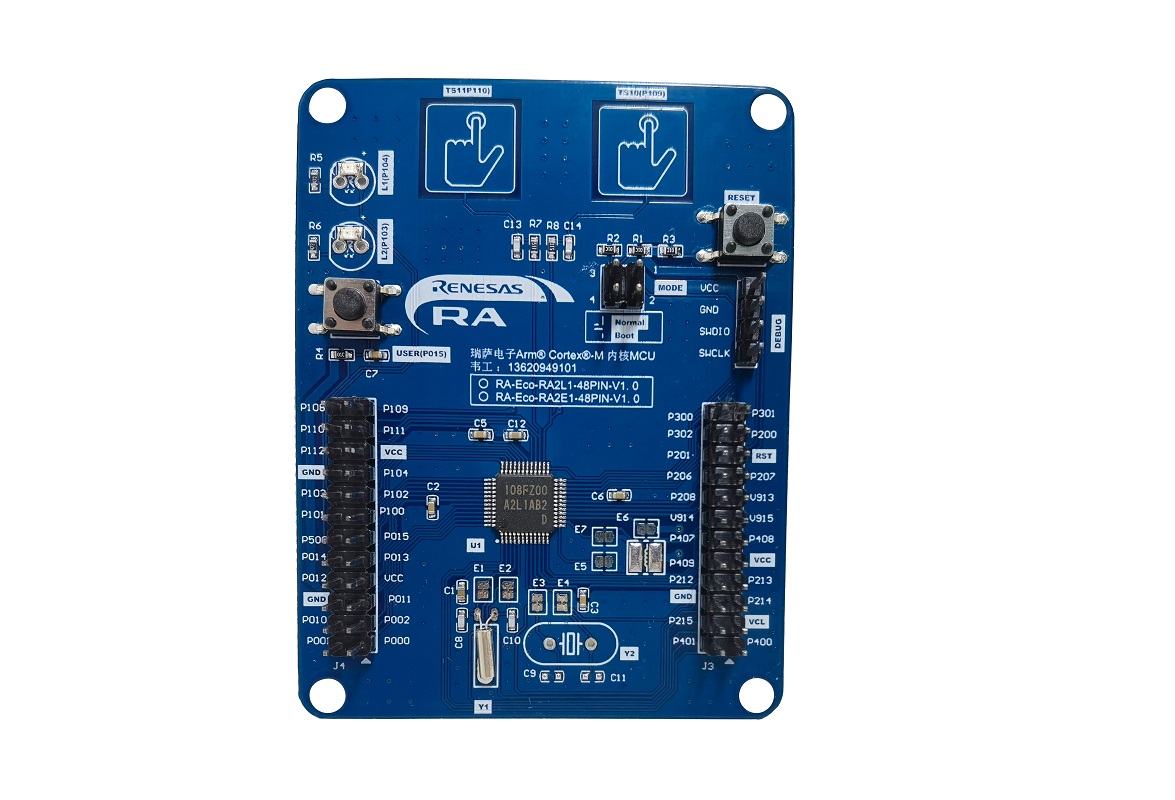
3.新建工程

4.工程模板
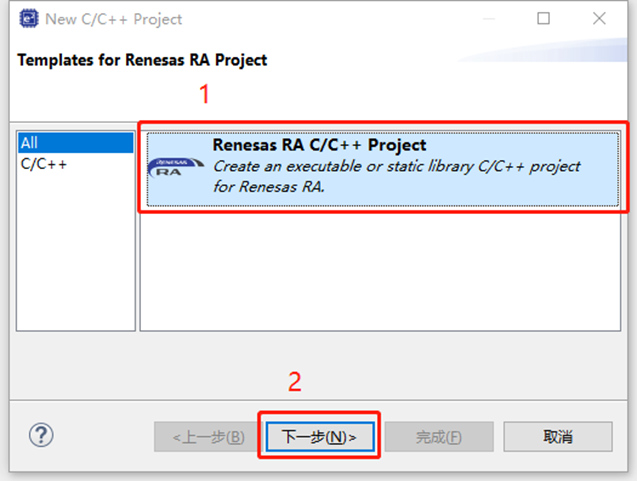
5.保存工程路径
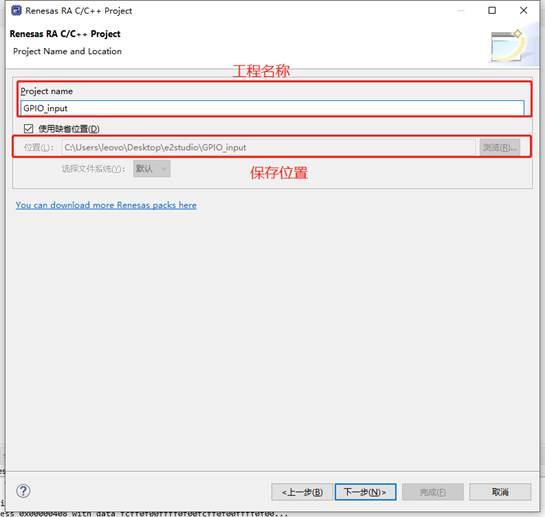
6.芯片配置
本文中使用R7FA2L1AB2DFL来进行演示。
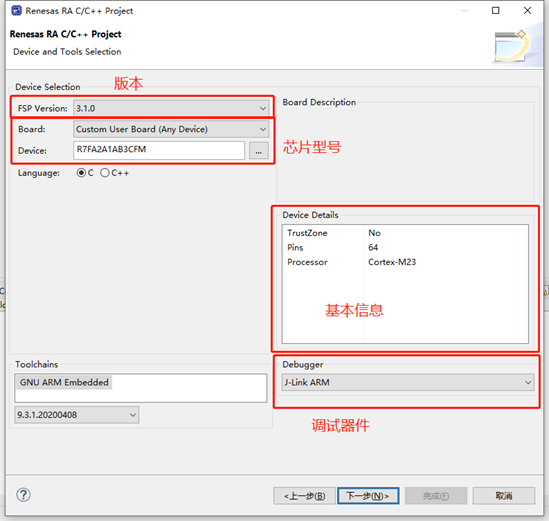
7
7.工程模板选择
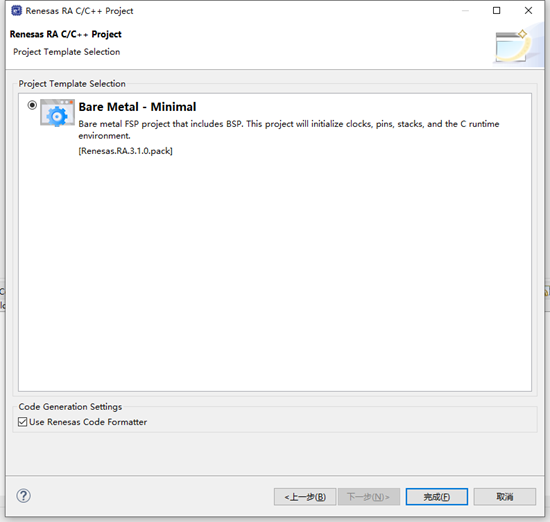
8.SPI配置
点击Stacks->New Stack->Driver->Connectivity->SPI Driver on r_spi。

9.SPI属性配置
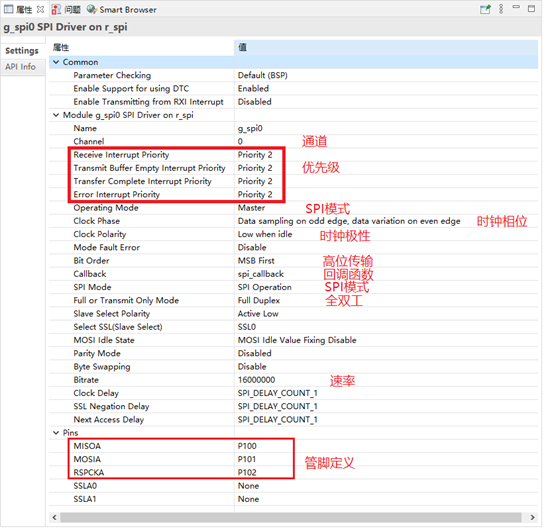
10.片选CS管脚设置
设置P103管脚为输出管脚,作为CS片选。
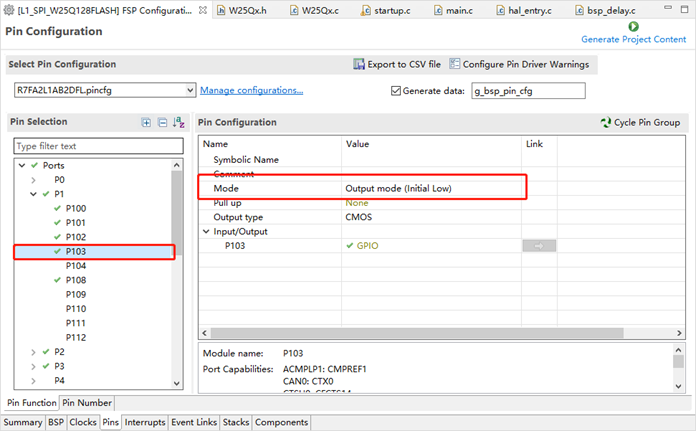
11.设置E2STUDIO堆栈
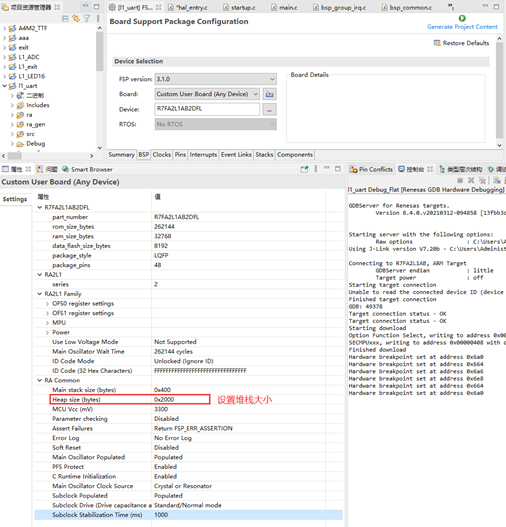
12.e2studio的重定向printf设置
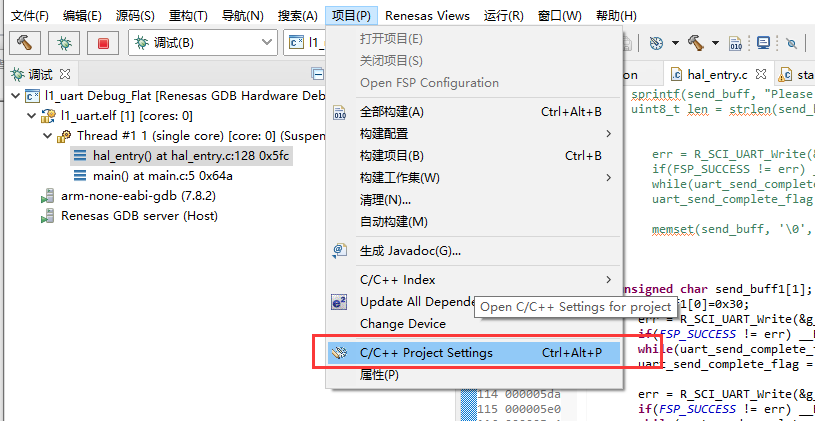
C++ 构建->设置->GNU ARM Cross C Linker->Miscellaneous去掉Other linker flags中的 “--specs=rdimon.specs”
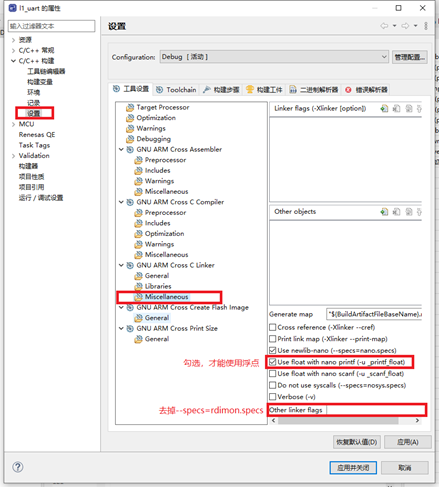
13.printf输出重定向到串口
打印最常用的方法是printf,所以要解决的问题是将printf的输出重定向到串口,然后通过串口将数据发送出去。
注意一定要加上头文件#include
#ifdef __GNUC__ //串口重定向
#define PUTCHAR_PROTOTYPE int __io_putchar(int ch)
#else
#define PUTCHAR_PROTOTYPE int fputc(int ch, FILE *f)
#endif
PUTCHAR_PROTOTYPE
{
err = R_SCI_UART_Write(&g_uart0_ctrl, (uint8_t *)&ch, 1);
if(FSP_SUCCESS != err) __BKPT();
while(uart_send_complete_flag == false){}
uart_send_complete_flag = false;
return ch;
}
int _write(int fd,char *pBuffer,int size)
{
for(int i=0;i;i++)>
14.stm32移植瑞萨说明
在STM32的W25Qx.h中,有个片选定义,代码如下。
#define W25Qx_Enable() HAL_GPIO_WritePin(CS_GPIO_Port, CS_Pin, GPIO_PIN_RESET)
#define W25Qx_Disable() HAL_GPIO_WritePin(CS_GPIO_Port, CS_Pin, GPIO_PIN_SET)
修改后如下所示。
#define W25Qx_Enable() R_IOPORT_PinWrite(&g_ioport_ctrl, BSP_IO_PORT_01_PIN_03, BSP_IO_LEVEL_LOW);
#define W25Qx_Disable() R_IOPORT_PinWrite(&g_ioport_ctrl, BSP_IO_PORT_01_PIN_03, BSP_IO_LEVEL_HIGH);
在STM32的W25Qx.c中,有对数据进行发送和接受,代码如下。
/* Send the read status command */
HAL_SPI_Transmit(&hspi1, cmd, 1, W25Qx_TIMEOUT_VALUE);
/* Reception of the data */
HAL_SPI_Receive(&hspi1,&status, 1, W25Qx_TIMEOUT_VALUE);
修改后如下所示。
/* Send the read status command */
g_transfer_complete = false;
err = R_SPI_Write(&g_spi0_ctrl, cmd, 1, SPI_BIT_WIDTH_8_BITS);
assert(FSP_SUCCESS == err);
/* Wait for SPI_EVENT_TRANSFER_COMPLETE callback event. */
while ( g_transfer_complete==false)
{
;
}
/* Reception of the data */
g_transfer_complete = false;
err = R_SPI_Read(&g_spi0_ctrl, &status, 1, SPI_BIT_WIDTH_8_BITS);
assert(FSP_SUCCESS == err);
/* Wait for SPI_EVENT_TRANSFER_COMPLETE callback event. */
while ( g_transfer_complete==false)
{
;
}
15.W25Q128说明
W25Q128将16M的容量分为256个块(Block),每个块大小为64K字节,每个块又分为16个扇区(Sector),每个扇区4K个字节。W25Q128的最小擦除单位为一个扇区,也就是每次必须擦除4K个字节。芯片ID如下所示。
0XEF13,表示芯片型号为W25Q80
0XEF14,表示芯片型号为W25Q16
0XEF15,表示芯片型号为W25Q32
0XEF16,表示芯片型号为W25Q64
0XEF17,表示芯片型号为W25Q128
16.演示效果
开机会打印W25Q128的ID,ID为0XEF17,实际如下所示。
并且之前保存的数据也正确读取出来了。
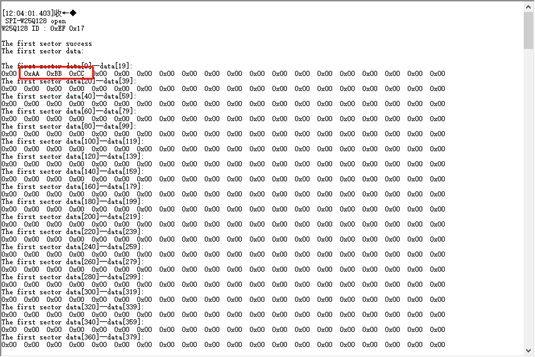
定义数组DataBuff,其中DataBuff[0]表示写入扇区, DataBuff[1]表示写入位置,剩下的为写入数据,同时以0xff结尾。
分别输入数据 01 02 01 02 03 04 ff与02 20 aa bb cc dd ff
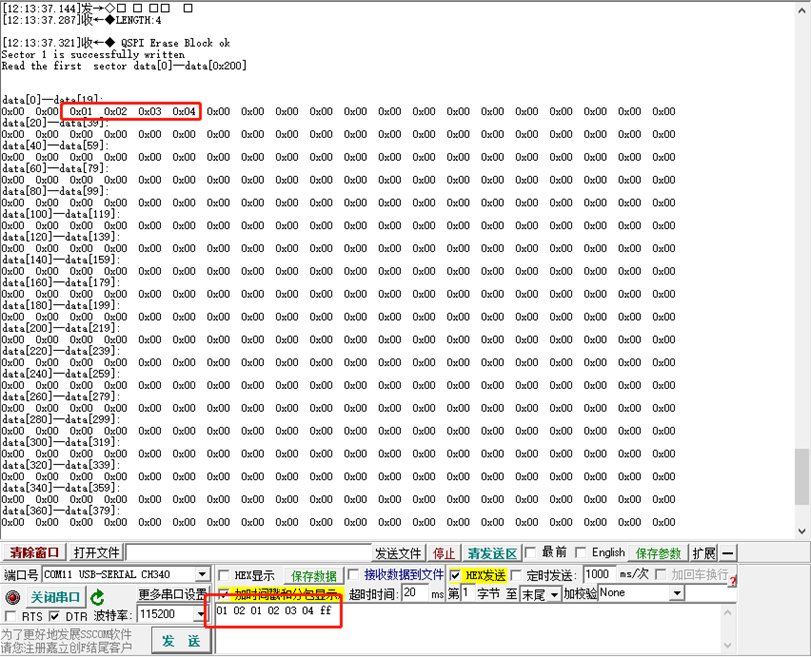
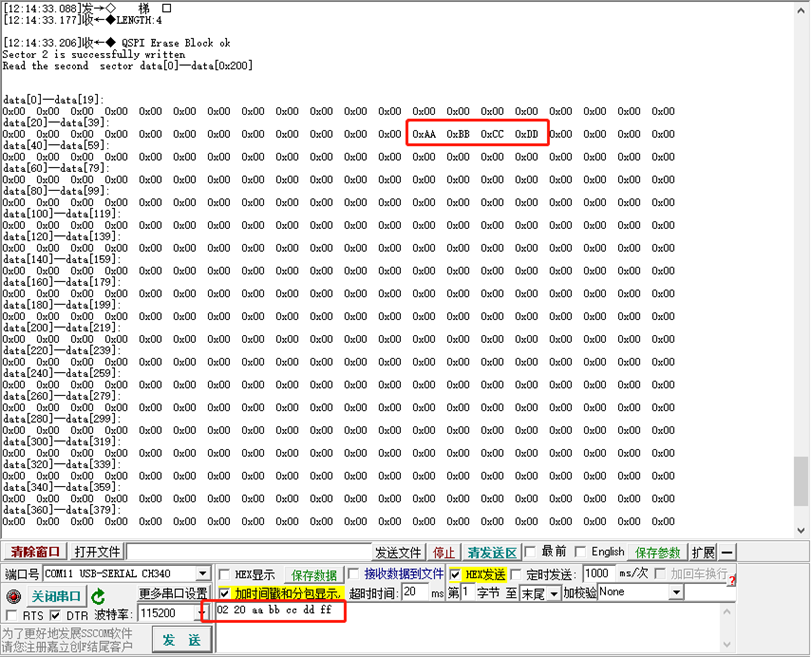
17.主程序代码
#include "hal_data.h"
#include
#include "W25Qx.h"
FSP_CPP_HEADER
void R_BSP_WarmStart(bsp_warm_start_event_t event);
FSP_CPP_FOOTER
void uart1_data(void);
#define BUFFERSIZE 255 //可以接收的最大字符个数
uint8_t ReceiveBuff[BUFFERSIZE]; //接收缓冲区
uint8_t recv_end_flag = 0,Rx_len=0;//接收完成中断标志,接收到字符长度
uint8_t wData1[0x200];
uint8_t wData2[0x200];
uint8_t wData3[0x200];
uint8_t rData1[0x200];
uint8_t rData2[0x200];
uint8_t rData3[0x200];
uint8_t ID[4];
uint32_t i;
uint8_t flag[1] ;
int i_flag = 0;
fsp_err_t err = FSP_SUCCESS;
volatile bool uart_send_complete_flag = false;
uint8_t RxBuff[1]; //进入中断接收数据的数组
uint8_t DataBuff[5000]; //保存接收到的数据的数组
int RxLine=0; //接收到的数据长度
int Rx_flag=0; //接受到数据标志
int Rx_flag_finish=0; //接受完成或者时间溢出
void user_uart_callback (uart_callback_args_t * p_args)
{
if(p_args->event == UART_EVENT_TX_COMPLETE)
{
uart_send_complete_flag = true;
}
if(p_args->event == UART_EVENT_RX_CHAR)
{
RxBuff[0] = p_args->data;
RxLine++; //每接收到一个数据,进入回调数据长度加1
DataBuff[RxLine-1]=RxBuff[0]; //把每次接收到的数据保存到缓存数组
Rx_flag=1;
Rx_len++;
if(RxBuff[0]==0xff) //接收结束标志位,这个数据可以自定义,根据实际需求,这里只做示例使用,不一定是0xff
{
Rx_flag_finish=1;
Rx_len--;
}
RxBuff[0]=0;
}
}
#ifdef __GNUC__ //串口重定向
#define PUTCHAR_PROTOTYPE int __io_putchar(int ch)
#else
#define PUTCHAR_PROTOTYPE int fputc(int ch, FILE *f)
#endif
PUTCHAR_PROTOTYPE
{
err = R_SCI_UART_Write(&g_uart1_ctrl, (uint8_t *)&ch, 1);
if(FSP_SUCCESS != err) __BKPT();
while(uart_send_complete_flag == false){}
uart_send_complete_flag = false;
return ch;
}
int _write(int fd,char *pBuffer,int size)
{
for(int i=0;ievent)
{
g_transfer_complete = true;
}
}
/*******************************************************************************************************************//**
* main() is generated by the RA Configuration editor and is used to generate threads if an RTOS is used. This function
* is called by main() when no RTOS is used.
**********************************************************************************************************************/
void hal_entry(void)
{
/* TODO: add your own code here */
err = R_SCI_UART_Open(&g_uart1_ctrl, &g_uart1_cfg);
assert(FSP_SUCCESS == err);
err = R_SPI_Open(&g_spi0_ctrl, &g_spi0_cfg);
assert(FSP_SUCCESS == err);
printf("rn SPI-W25Q128 openn");
/*##-1- Read the device ID ########################*/
BSP_W25Qx_Init();//初始化W25Q128
BSP_W25Qx_Read_ID(ID);//读取ID
if((ID[0] != 0xEF) | (ID[1] != 0x17))
{
printf("SPI-W25Q128 error");
}
else//ID正确,打印ID
{
printf("W25Q128 ID : ");
for(i=0;i<2;i++)
{
printf("0x%02X ",ID[i]);
}
printf("rnrn");
}
/**************************读取第1扇区数据**************************************************************/
/*##-3- Read the flash ########################*/
/*读取数据,rData读取数据的指针,起始地址0x00,读取数据长度0x200*/
if(BSP_W25Qx_Read(rData1,0x0,0x200)== W25Qx_OK)
printf("The first sector successn");
else
printf("The first sector errorn");
/*打印数据*/
printf("The first sector data: rn");
for(i =0;i<0x200;i++)
{
if(i%20==0)
printf("nThe first sector data[%d]--data[%d]: rn",i,i+19);
printf("0x%02X ",rData1[i]);
}
printf("n");
/**************************读取第2扇区数据**************************************************************/
/*##-3- Read the flash ########################*/
/*读取数据,rData读取数据的指针,起始地址0x1000,读取数据长度0x200*/
if(BSP_W25Qx_Read(rData2,0x1000,0x200)== W25Qx_OK)
printf("The second sector successn");
else
printf("The second sector errorn");
/*打印数据*/
printf("The second sector data: rn");
for(i =0;i<0x200;i++)
{
if(i%20==0)
printf("nThe second sector data[%d]--data[%d]: rn",i,i+19);
printf("0x%02X ",rData2[i]);
}
printf("n");
/**************************读取第3扇区数据**************************************************************/
/*##-3- Read the flash ########################*/
/*读取数据,rData读取数据的指针,起始地址0x2000,读取数据长度0x200*/
if(BSP_W25Qx_Read(rData3,0x2000,0x200)== W25Qx_OK)
printf("The third sector successn");
else
printf("The third sector errorn");
/*打印数据*/
printf("The third sector data: rn");
for(i =0;i<0x200;i++)
{
if(i%20==0)
printf("nThe third sector data[%d]--data[%d]: rn",i,i+19);










